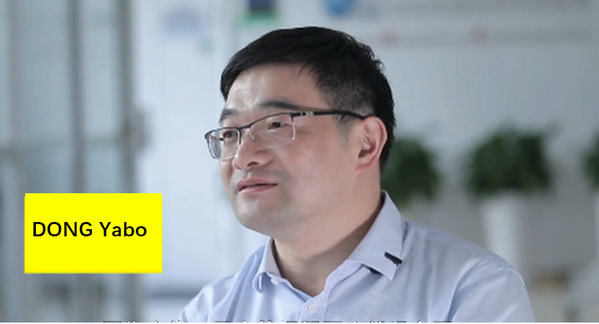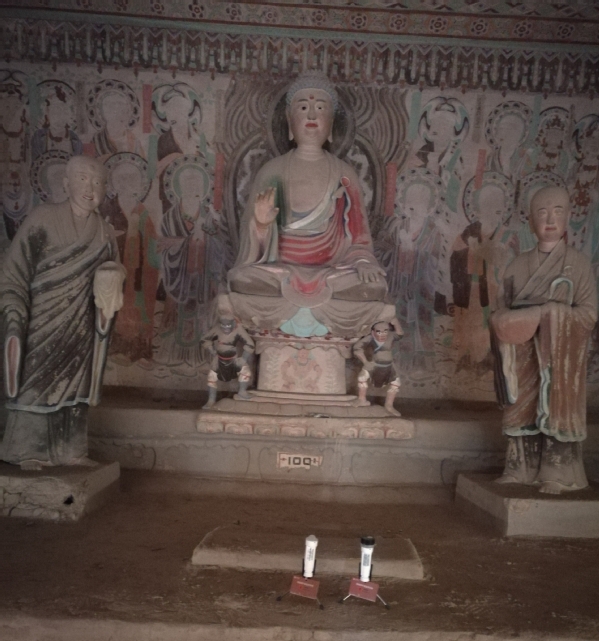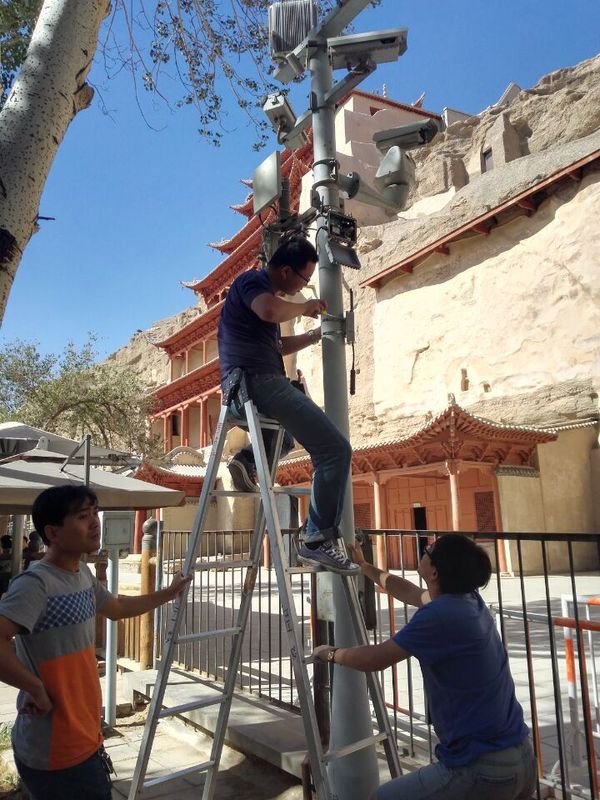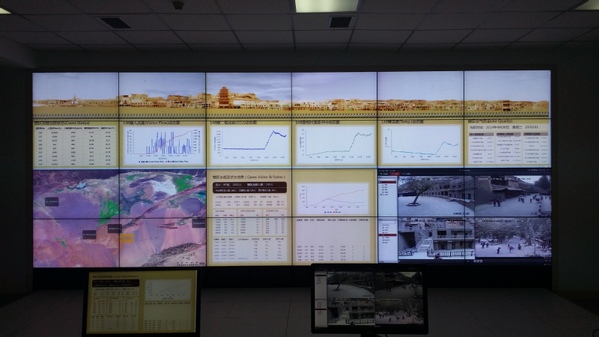The Mogao Grottoes, which boast a brilliant history of several millennia, are located in Dunhuang, at the western end of the Hexi Corridor.
In this treasure trove of civilization, architecture, painted sculptures and paintings are integrated in an exquisite and splendid manner. However, unlike museum collections, which are meticulously tended in a constant environment, murals in these caves have been exposed to wind and sand for the past millennia.
Each generation has been guarding and protecting the Mogao Grottoes. Since 2006, Assoc. Prof. DONG Yabo, Deputy Director of the Institute of Artificial Intelligence at Zhejiang University School of Computer Science and Technology, has become one of the guardians. He has installed an environmental monitoring system to chronicle the "warm and cold signs" of artworks, which enables experts in heritage conservation to "prescribe a better cure".

Challenge of preservation
Murals in Dunhuang are emblematic of boldness and vigor and visitors are able to get an up-close appreciation of the craft and ingenuity of ancient people. But this also puts murals in peril because when humidity exceeds 62%, salt will precipitate from the deeper layers of the murals and crystallize on their surfaces, thereby causing them to deteriorate and rupture.
Previously, the monitoring information regarding temperature, humidity and carbon dioxide could only be extracted manually at intervals. "This kind of monitoring is far from timely," said DONG Yabo. "We must develop and install a real-time environmental monitoring system."
DONG Yabo paid his first visit to the Mogao Grottoes in 2006. He was shocked at what he saw. The cramped space in these caves with a collection of imposing murals made it extremely tough to carry out monitoring work. Moreover, there was virtually no signal in caves and their special shapes completely blocked wireless signals. Due to the need to protect cultural relics, there was no power supply to set up network cables in caves.
IoT Technology?
Everything was fraught with difficulties. DONG Yabo thought of the then newly-emerging Internet of Things technology which could transmit signals via the wireless sensing network. Although this technology was successfully applied in industry, it was bulky and inconvenient to use in caves. On top of that, the application of this technology may produce an adverse effect on the environment of caves and mural relics. Thus, it was a herculean task to transplant ready-made technology to the field of heritage conservation. Everything had to start from scratch.
From the perspective of heritage conservation, the installation of sensors should neither damage murals nor affect visitors' appreciation. The team led by DONG Yabo allowed data to be delivered in relay through a low-power multi-hop ad hoc structure. This sensor could collect information about humidity, temperature and carbon dioxide in the air. Without a power source, it could work with two batteries for a whole year.

How to reduce the power consumption of the sensor?
How could power consumption be reduced? The team managed to compress the working time of the sensor by keeping it dormant when it was not at work. For the transmission of data in one minute, the sensor should complete a chain of work, including looking for signals, receiving data from upstream sensors, looking for downstream sensors, sending data and receiving responses, within tens of milliseconds.
At the hardware level, DONG Yabo led the team to design a sensor that could reduce its power consumption as much as possible and make it small enough to avoid the impact on the cave landscape. At the software level, they managed to ensure the sensors' efficiency.
How to render IoT technology stable?
With the installation of one sensor after another, data was constantly transmitted. "The environment was extremely complex and the signal was considerably unstable, so we had no idea when it would fail to work all of a sudden," DONG Yabo said, "We were very frustrated and even suffered a breakdown."
The research team engaged in problem detection and technological iterations to make the IoT technology more stable. On the one hand, they conquered various difficulties in low-power multi-hop ad hoc technology through scrupulous work in development and testing, and improved the stability of sensors gradually via code upgrading. On the other hand, they designed signal relay locations in accordance with the characteristics of each cave to ensure that there were safe and stable signal transmission channels in different caves.

When the monitoring system became stable in 2011, over 100 caves were equipped with the second-generation environmental monitoring sensors. In the Mogao Grottoes, weather stations and air pollution monitoring stations were also set up. These sensors played the role of "watchdogs" over cultural relics.
A large electronic screen will rivet the attention of a visitor once he or she enters the Dunhuang Academy Monitoring Center. Small green dots represent normal conditions in such indictors as temperature, humidity and carbon dioxide concentration. Once these indictors reach the alert value, small dots will turn red and a series of visitor scheduling systems will start. If temperature and humidity inside the cave are higher than those outside because of the number of visitors, a series of measures, such as flow restrictions and ventilation, will be initiated. If atmospheric humidity is high enough to affect that inside the cave, the door will be closed so as to stabilize the interior environment.

"The team led by DONG Yabo has done an incredible job," said FAN Jinshi, the former dean of Dunhuang Academy.
With more in-depth research, the research team monitors not only the environment inside caves, but also relics in tilting or cracking. DONG Yabo has also set up a local team in Dunhuang, and Dunhuang Academy has established a professional heritage conservation monitoring center, which is one of the earliest centers in the field of cultural heritages in China.
Cloud technology
As compared to real-time data collected in industrial or civilian fields which could be periodically erased or compressed, these historical data are of immense value to cultural relics. "In heritage conservation, historical data can be tapped to create a constant model for the preservation environment and the heritage state, providing a crucial basis for early warnings of heritage hazards in the future. These data are therefore of appreciable value and cannot be deleted."
As billions and billions of data piled up, problems arose. The bigger the space storage was, the slower data queries would be. "Afraid that the server would break down, we dare not retrieve data in a previous year."
There was another headache for DONG Yabo. Sometimes, there would be power failures in the Mogao Grottoes, causing the transmission network stoppage. At this time, sensors would automatically store data, and when power supply was resumed, temporarily stored data on sensors would flood to the server simultaneously. This made DONG Yabo apprehensive of the security of data, fearing that data would be lost.
Cloud technology is developing radically, and data writing and access performance have been tremendously improved. Through the Intelligent Cloud Lab jointly set up by Zhejiang University and Alibaba, the team led by DONG Yabo and cloud technology experts from Alibaba worked in collaboration to resolve the problems regarding storage and management of massive data.
Today, the team led by DONG Yabo is expanding their research and application in the hope of training more and smarter electronic "watchdogs" for other cultural heritage institutions. "The preventive protection of cultural relics is quite challenging and formidable, but we want to make more cultural relics 'live' for another millennium through technology," said DONG Yabo.






